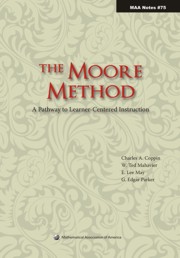Book contents
- Frontmatter
- Contents
- Dedication
- Acknowledgements
- 1 Introduction
- 2 Moore's Moore Method
- 3 What is the Moore Method?
- 4 On Culture
- 5 Development and Selection of Materials
- 6 In the Classroom
- 7 Grading
- 8 Why Use the Moore Method?
- 9 Evaluation and Assessment: Effectiveness of the Method
- 10 Frequently Asked Questions
- Appendices
- I Coppin
- II Mahavier
- III May
- IV Parker
- About the Authors
- References
- Index
III - May
from Appendices
- Frontmatter
- Contents
- Dedication
- Acknowledgements
- 1 Introduction
- 2 Moore's Moore Method
- 3 What is the Moore Method?
- 4 On Culture
- 5 Development and Selection of Materials
- 6 In the Classroom
- 7 Grading
- 8 Why Use the Moore Method?
- 9 Evaluation and Assessment: Effectiveness of the Method
- 10 Frequently Asked Questions
- Appendices
- I Coppin
- II Mahavier
- III May
- IV Parker
- About the Authors
- References
- Index
Summary
Syllabus for Introduction to Abstract Mathematics
SALISBURY UNIVERSITY
DEPARTMENT OF MATHEMATICS & COMPUTER SCIENCE
SYLLABUS (Tentative)
MATH 300 Introduction to Abstract Mathematics
Intended Audience: Students minoring in mathematics, particularly prospective teachers, will find this a good capstone to their undergraduate mathematical experience. Students majoring in mathematics who have not already completed a 400-level mathematics course will find this a valuable course to help them develop a better understanding of the connection between computational and theoretical mathematics.
Objective: To provide students with an opportunity to develop the foundations of abstract mathematics in a manner similar to that employed by professional mathematicians.
Prerequisite: Discrete Mathematics, completed with a grade of C or better.
Text: Notes distributed by the instructor.
Foundations, I: The Theory of Sets (2 weeks)
Points and sets. Axioms on sets. Subsets. Operations on sets.
Foundations, II: Functions (3–4 weeks)
Ordered pairs. Relations, functions, and operations. Injections, surjections, and bijections. Binary operations and their properties.
A Deeper Look at the Real Numbers (3–4 weeks)
The integers. Algebraic and order properties. Completeness. Supremum Property. Intervals, decimals, and rational and irrational numbers. Mathematical induction. The Archimedean Property. Recursion. Primes. Finiteness and infinity. Countability and uncountability.
Equivalence Relations (2 weeks)
Reflexivity, symmetry, and transitivity. The Equivalence-Relation Theorem. Elementary functions.
Information
- Type
- Chapter
- Information
- The Moore MethodA Pathway to Learner-Centered Instruction, pp. 211 - 216Publisher: Mathematical Association of AmericaPrint publication year: 2009
